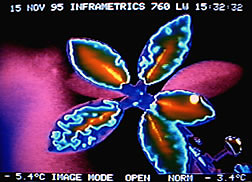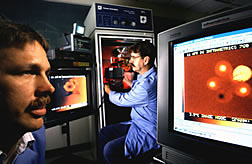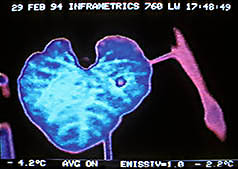Using Heat To Study Ice Damage in Plants
Frost, farmers will tell you, is one of their greatest enemies in early spring.
That same glistening layer of frosted ice that so beautifully catches the rays of an early-morning sun can mean death to tender, newly emerging plant or bud growth.
A sudden spring freeze severely damaged the peach crop in the northeastern United States in 1994. Freeze damage to citrus and tomato crops often costs growers millions of dollars and limits supplies, causing consumers to pay higher prices.
Not very much is known about how plants freeze, according to ARS plant physiologist Michael Wisniewski.
He says, “Until now, we had no way to tell which part of a plant freezes first or when the ice actually forms. For example, on a bean plant, can one leaf freeze and another not? Do leaves freeze before the stems, or vice versa? Does the entire plant sometimes freeze at the same time?
“Some plants can’t recover from damage inflicted by unseasonable freezes,” says Wisniewski. “The extent of the damage depends on the dip in the temperature. But we're not talking about extreme weather; just 28° F to 30° F can be destructive to new growth.
“Cold temperatures alone don't usually damage new plant growth, but ice formation in frost-sensitive crops can be lethal,” Wisniewski explains." Plants don't freeze right at 32° F. They freeze over a wide range of temperatures below 32° F, depending on various factors that induce ice formation. To protect plants, we need to know where in a particular plant the ice formation begins and how it progresses throughout the plant. We can stop it only if we understand how it happens.”
And he is finding out. Wisniewski is the first to use a new technology involving heat energy, or infrared, to determine where ice first begins to form in a plant and at what temperature.
Because small amounts of heat are released by a liquid as it freezes—that is, as it changes from a liquid to a solid—Wisniewski can use infrared video thermography to watch a plant freeze and follow the progress of ice formation throughout the plant.
Until now, the only way he could have studied ice formation was by attaching thermocouples (an electrical wire attachment that can pick up a change in electrical flow) to detect when a plant had completely frozen. But thermocouples yield little information about the original site of ice formation or the pattern of damage caused by freezing.
At the ARS Appalachian Fruit Research Station in Kearneysville, West Virginia, Wisniewski has used this infrared camera system to track ice crystals as they form in apple, peach, and pear trees and in bean, potato, and strawberry plants.
"The procedure is quite simple," he says. "We put the potted plants in an environmental chamber, lower the temperature at a specific rate, point the infrared camera at the plants, and watch the ice form. The process is recorded on video tape. We can use computer software to analyze the video tape to study all stages of ice formation."
One of the surprises that Wisniewski encountered with bean plants was that the nodes—the site where leaves attach to the plant stem—hinder ice formation. Ice forms fairly quickly along the stem of the plant but slows as it approaches the nodes. Also, while shoots freeze quickly, ice formation progresses very slowly into the roots.
Says Wisniewski, "In peach trees, we found that even when stems freeze before the flowers, ice does not automatically form in the flowers, as you would think. Current theory is that once shoots freeze, all flowers along the stem freeze. But we know it can be just the opposite. Our work shows that ice formation in plants is much more complicated than has been thought."
The following example of how thermal imaging works was reported in the February 1997 issue of Plant Physiology.
In a cold-room demonstration, Wisniewski placed a small sample of ice-nucleating bacteria on one lobe of a bean leaf and a drop of water on the other and trained the infrared camera on the plant. The drop of water appeared black through the camera because the water temperature was lower than that of the leaf. The camera was set to depict all areas with a temperature below about 29° F as black and areas above 31° F as white.
The drop of bacterial cells began to freeze first. This started ice forming in the remaining part of the leaf, which completely froze in 2 minutes and 25 seconds. From the leaf, formation of the ice progressed down the petiole into the stem and throughout the entire bean plant.
“The drop of water on the surface of the leaf froze, independently, at least 2.5 minutes after the part of the leaf containing the bacteria,” Wisniewski reports.
Why is it so important to know how ice forms when plants freeze?
Plants can survive freezing temperatures by avoiding ice formation, a process called supercooling. If the temperature drops too low, however, the ice crystals that develop will cause more injury than ice crystals that form at higher freezing temperatures. Ice forms more slowly at warmer temperatures, which gives the plant time to acclimate itself to drastic changes. Also, slowly formed ice crystals are smaller than those formed more rapidly.
When ice forms slowly, water has time to escape from plant cells so that ice forms in the spaces between the cells, not inside them. A more sudden, sharp drop in temperature traps water inside cells, causing ice crystals to form that burst the cells, killing them.
"If we can figure out just how it all happens, then we can develop logical ways to block the ice formation, either genetically or mechanically," says Wisniewski.
“The reason plants in nature normally freeze a few degrees below 32° F is the presence of ice nucleators such as the ice-nucleating bacterium, Pseudomonas syringae.
"With the new thermal system, we're able to study not only this bacterium, but other external and internal factors that affect a plant's response to freezing temperatures," Wisniewski says.
Steven E. Lindow, one of Wisniewski's collaborators from the University of California at Berkeley, has shown that eliminating the bacteria from plant tissue surfaces allows plants to protect themselves from freezing.
Lindow has actually introduced antagonistic organisms on the surface of plants that compete for the same space but don't induce freezing.
Wisniewski says there are other agents besides bacteria that induce water to freeze at lower temperatures. "Plants react differently to temperatures—depending on the environment, humidity, or even whether a night is still or windy," he says.
To watch ice freeze in plants, Wisniewski uses an Inframetrics model 760 imaging radiometer, which can visually record ice forming in very small droplets of water and estimate the surface temperature of plants. Technology involving infrared cameras that sense heat is being used by the Department of Defense and also by utility companies to fly over power lines to detect hot spots, thus identifying potential problems before they happen. In industrial boilers, these cameras can sense a hairline crack that can be fixed, saving thousands of dollars, and sometimes lives as well.
“Used in agriculture, thermal imaging can save growers money, increase production, and help ensure consumers a good selection of produce at a reasonable price,” Wisniewski says. — By Doris Stanley, ARS.
Michael E. Wisniewski is at the USDA ARS Appalachian Fruit Research Station, Kearneysville, WV; phone (304) 725-3451 ext. 320









